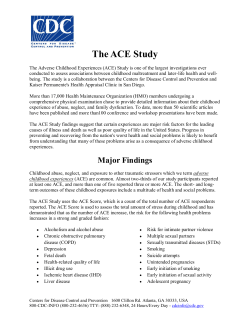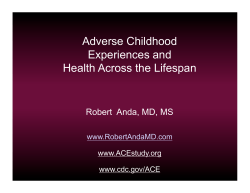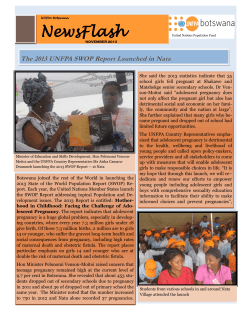
Adverse Childhood Experiences and Implications for Adolescent Pregnancy Prevention Programs April 2014
Adverse Childhood Experiences and Implications for Adolescent Pregnancy Prevention Programs April 2014 Adverse childhood experiences can include multiple traumatic exposures during childhood. Such experiences can increase the likelihood of unhealthy behaviors, such as early sexual initiation and risky sexual behaviors. Adverse childhood experiences are also associated with changes in brain structure that lead to long-term health and social consequences, including adolescent pregnancy. This tip sheet provides a description of adverse childhood experiences and their implications for adolescent pregnancy prevention (APP) programs. TYPES OF ADVERSE CHILDHOOD EXPERIENCES The primary types of adverse childhood experiences are abuse, neglect, and family dysfunction. There are many other types of childhood trauma; however, the hallmark Adverse Childhood Experiences Study (ACE Study) (Felitti & Anda, 1997), from which much of our current thinking has emerged, found the following 10 adverse childhood experiences to be the most common. Abuse Neglect Family Dysfunction Emotional abuse Emotional neglect Intimate partner violence Physical abuse Physical neglect Mental health issues Sexual abuse Substance use disorders Parental separation or divorce Incarcerated family member THE CO-OCCURRING NATURE OF ADVERSE CHILDHOOD EXPERIENCES Traumatic experiences rarely take place as isolated events. Rather, they typically occur within the context of multiple adversities, such as dysfunctional families and/or disorganized communities (Hillis et al., 2004, Dube et al., 2002). The consequences of an adverse experience may only become apparent after years of cumulative exposure to multiple adversities. In response to the co-occurring nature of adverse childhood experiences, the ACE Study used the ACE score as a measure of an individual’s cumulative exposure to adverse experiences during childhood. In determining an individual’s ACE score, one point is given for exposure to each of the 1 different categories (e.g., sexual abuse, emotional neglect, or family members with mental health issues) of adversity. For example, an ACE score of zero reflects no exposure to any of the categories of adversity, and an ACE score of 10 reflects exposure to all of the categories. The number of times a person has experienced a particular adverse event is not factored into the ACE score. IMPACT OF ADVERSE CHILDHOOD EXPERIENCES ON DEVELOPMENT AND COPING BEHAVIOR Knowing how adverse childhood experiences influence a young person’s health and development provides clues for potential intervention. Research identifies multiple pathways linking early adverse experiences to later health consequences. As adversities accumulate in a young person’s family or community, the positive exposures necessary for healthy development (e.g., nurturing and responsive caregivers, positive role models, or enriching activities) are more likely to become disrupted, affecting a child’s social, emotional, and cognitive development (Evans et al., 2013). Adversities not only limit positive exposures, they are also stressful. Although moderate amounts of stress can be protective by enabling a young person to respond and adapt to a challenge, chronic stress may be too much for a young person to handle using the coping skills and resources they have available (McEwen & Gianaros, 2010). In fact, early and chronic stress is associated with long-term changes in brain structure and function (De Bellis & Thomas, 2003). The brain plays a central role in determining what is stressful and triggering the physiological and behavioral responses that help an individual adapt (McEwen & Gianaros, 2010). The same regions of the brain that manage stress are also most vulnerable to prolonged periods of stress. This is particularly true in childhood and adolescence when these brain regions are developing rapidly—they may not be fully developed until age 25 (Lupien et al., 2009). For example, too much stress can inhibit growth of the hippocampus (responsible for learning and memory) and the prefrontal cortex (which is important for decision-making, attention, regulating emotions, and impulsivity) (Lupien et al., 2009; McEwen & Gianaros, 2010) (see Figure 1). Research shows that children who have trouble processing information in school because of learning challenges or difficulty paying attention are academically less successful and more likely to engage in other risk behaviors (Lanza & Rhoades, 2013). The amygdala is another brain region (important for detecting and responding to threats) that is impacted by chronic stress. However, unlike the hippocampus and prefrontal cortex, the amygdala actually becomes more responsive with repeated stress. As a result, young people may become hyper-vigilant to a perceived threat, interpreting ambiguous social cues as threatening (McEwen & Gianaros, 2010). This behavior may interfere with a young person’s ability to build trusting relationships with adults, peers, or intimate partners. Our understanding of how the brain influences learning is growing rapidly, so instructional Figure 1. Regions of the Brain approaches and interventions should always apply lessons from “the latest findings” with caution. Relationship difficulties among those who have experienced childhood adversity may take the form of having multiple or superficial sexual partnerships, engaging in unprotected sexual intercourse, or becoming involved in adolescent pregnancy (Briere & Elliott, 1994; Homma et al., 2012). These relationship difficulties are found 2 to result from a sense of powerlessness and low self-esteem created by the abuse experience; from the use of sex to secure affection and intimacy; and from low assertiveness, which makes it difficult to negotiate contraceptive use (Saewyc, Magee, & Pettingell, 2004; Kendall-Tackett, 2002; Wilson, 2008). The relationship between experiencing childhood adversity and adolescent pregnancy is relevant for both genders: Women who had experienced childhood sexual abuse were found to be 2.2 times more likely to report pregnancy during adolescence compared with those with no history of abuse (Noll, Shenk, & Putnam, 2009). Boys who experienced sexual abuse were nearly 5 times more likely to report causing a pregnancy during adolescence compared with boys with no history of abuse (Homma et al., 2012). Families can be the most powerful sources of stress or the greatest protectors against the harmful effects of stress (Gunnar & Quevedo, 2007). For girls who experienced child abuse or household dysfunction, family strength has proven to be especially protective against early sexual initiation (Hillis, 2010). Similarly, research found that the positive relationship between an adolescent girl and her parents was associated with a reduced likelihood of adolescent pregnancy (Dittus & Jaccard, 2000; Lee, 2001). IMPLICATIONS FOR ADOLESCENT PREGNANCY PREVENTION APP programs cannot undo the adverse experiences a young person has already experienced. However, there are some practical steps that APP programs can take to address adverse childhood experiences: APP programs can use ACE Study data to identify youth who may be at higher risk of adolescent pregnancy. This can be done by using their ACE score and targeting programming to these youth. The ACE score can be used as a guide to a person’s risk for health consequences in much the same way a person’s blood pressure or cholesterol communicates risk for heart disease or stroke. The ACE score was originally derived from the Family Health History and Health Appraisal questionnaires (http://www.cdc.gov/ace/questionnaires.htm), which collect information on childhood maltreatment, household dysfunction, and other socio-behavioral factors examined in the ACE Study. Programs may find the 10-question ACE screener (http://acestudy.org/ace_score) to be useful as part of their recruitment or assessment protocol. APP programs can take a trauma-informed approach to how they interact with their participants. For more information on trauma-informed care, please view the trauma-informed care Webinar available on the Family and Youth Services Bureau Website (http://www.acf.hhs.gov/programs/fysb/resource/aegp-tic20121214). APP programs can include program components that encourage and support the development of family connectedness and ameliorate the effects of family dysfunction. APP programs can develop partnerships with state and local agencies that work with youth who have been removed from their homes due to family dysfunction and target programming to these youth. APP programs can focus on family strength as a way to provide continuous, progressive, and timely guidance that can contribute to improved adolescent decision-making about sexual and reproductive health issues (Hillis, 2010). 3 REFERENCES AND RESOURCES Briere, J. N., & Elliott, D. M. (1994). Immediate and long-term impacts of child sexual abuse. Future Child 4(2), 54–69. De Bellis, M., & Thomas, L. (2003). Biologic fındings of post-traumatic stress disorder and child maltreatment. Current Psychiatry Reports, 5(2), 108 –117. Dube, S. R., Anda, R. F., et al. (2002). Exposure to abuse, neglect, and household dysfunction among adults who witnessed intimate partner violence as children: Implications for health and social services. Violence and Victims, 17(1), 3–17. Evans, G. W., Li, D., & Whipple, S. S. (2013). Cumulative risk and child development. Psychological Bulletin, 139(6), 1342–1396. Felitti, V. J., & Anda, R. F. (1997). The Adverse Childhood Experiences (ACE) study. Retrieved February 25, 2014, from http://www.cdc.gov/ace/index.htm. Gunnar, M., & Quevedo, K. (2007). The neurobiology of stress and development. Annual Review of Psychology, 58, 145–173. Hillis, S. D., Anda, R. F., Dube, S. R., Felitti, V. J., Marchbanks, P. A., & Marks, J. S. (2004). The association between adverse childhood experiences and adolescent pregnancy, long-term psychosocial consequences, and fetal death. Pediatrics, 113(2), 320–327. Hillis, S. D., Anda, R. F., Dube, S. R., Felitti, V. J., Marchbanks, P. A., Macaluso, M., & Marks, J. S. (2010). The protective effect of family strengths in childhood against adolescent pregnancy and its long-term psychosocial consequences. The Permanente Journal, 14(3), 18–27. Homma, Y., N. Wang, Saewyc, E., & Kishor, N. (2012). The relationship between sexual abuse and risky sexual behavior among adolescent boys: A meta-analysis. Journal of Adolescent Health, 51(1), 18–24. Kendall-Tackett, K. (2002). The health effects of childhood abuse: Four pathways by which abuse can influence health. Child Abuse and Neglect, 26, 715–729. Lanza, S. T., & Rhoades, B. L. (2013). Latent class analysis: An alternative perspective on subgroup analysis in prevention and treatment. Prevention Science, 14(2), 157–168. Lee, M. C. (2001). Family and adolescent childbearing. Journal of Adolescent Health, 28(4), 307–312. Lupien, S. J., McEwen, B. S., Gunnar, M. R., & Heim, C. (2009). Effects of stress throughout the lifespan on the brain, behaviour and cognition. Nature Reviews: Neuroscience, 10(6), 434–445. McEwen, B. S., & Gianaros, P. J. (2010). Central role of the brain in stress and adaptation: Links to socioeconomic status, health, and disease. Annals of the New York Academy of Science, 1186, 190–222. Noll, J. G., Shenk, C. E., & Putnam, K. T. (2009). Childhood sexual abuse and adolescent pregnancy: A metaanalytic update. Journal of Pediatric Psychology, 34(4), 366–378. Saewyc, E. M., Magee, L. L., & Pettingell, S. E. (2004). Teenage pregnancy and associated risk behaviors among sexually abused adolescents. Perspect Sex Reprod Health, 36, 98–105. Wilson, H. W., & Widom, C. . (2008). An examination of risky sexual behavior and HIV in victims of child abuse and neglect: A 30-year follow-up. Health Psychology, 27, 149–158. 4 This tip sheet was funded by the U.S. Department of Health and Human Services, Administration on Children, Youth and Families, Family and Youth Services Bureau under a contract to RTI International (contract # HHSP23320095651WC Task 25). RTI International partners with ETR Associates, Healthy Teen Network, The National Campaign to Prevent Teen and Unplanned Pregnancy, and Native American Management Services to provide adolescent pregnancy prevention training and technical assistance on this project. If you have any questions, please contact Barri Burrus, PhD, Project Director, or Frances Gragg, MA, Associate Project Director, at PREPTA@rti.org. Suggested Citation: Hawkins-Anderson, S., & Guinosso,S. (2014). Adverse Childhood Experiences and Implications for Adolescent Pregnancy Prevention Programs. Washington, DC: Administration on Children, Youth and Families, Family and Youth Services Bureau. 5
© Copyright 2025





















